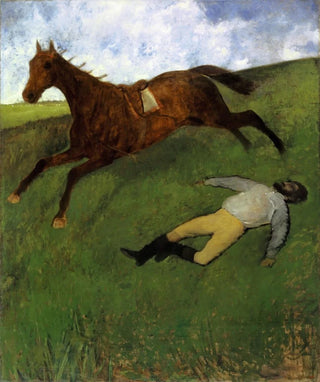Art print | Injured jockey - Edgar Degas Source: Reproduction | Jockey blessé - Edgar Degas


View from behind

Frame (optional)
In the fascinating world of art, certain works stand out for their ability to capture intense emotions and fleeting moments. "Jockey blessé" by Edgar Degas is one of those iconic pieces that, beyond its visual representation, evokes a poignant story and an atmosphere filled with tension. Created in 1896, this art print immerses us in the world of horse racing, a subject dear to Degas, while confronting us with the fragility of life and the inherent pain of competition. The scene depicts a jockey fallen from his horse, a powerful image that, through its brutality, prompts the viewer to reflect on the nature of risk and passion.
Style and uniqueness of the art print
Degas's style is distinguished by his mastery of movement and light, elements that take on a special dimension in "Jockey blessé". The artist employs bold brushstrokes and rich colors to create a vibrant, almost tangible atmosphere. The posture of the jockey, both dynamic and tragic, is captured with precision that reflects Degas's meticulous observation of his subjects. The details of the horse, as well as the expressions of pain and despair on the jockey's face, reveal a deep sensitivity that transcends mere representation. This art print is a perfect example of Impressionism, where light and movement combine to bring a scene to life that, although frozen, seems to vibrate with energy.
The artist and his influence
Edgar Degas, a major figure of the Impressionist movement, left a lasting mark on his era with his unique vision of beauty and everyday life. Born in 1834 in Paris, he initially focused on classical painting before turning to more contemporary subjects, notably dancers and horse races. His ability to capture moments of life with such intensity influenced many artists, both of his time and subsequent generations. Degas did not limit himself to painting scenes of Parisian life; he also explored darker themes, such as suffering and vulnerability, as exemplified by "Jockey blessé". His innovative approach

Matte finish

View from behind

Frame (optional)
In the fascinating world of art, certain works stand out for their ability to capture intense emotions and fleeting moments. "Jockey blessé" by Edgar Degas is one of those iconic pieces that, beyond its visual representation, evokes a poignant story and an atmosphere filled with tension. Created in 1896, this art print immerses us in the world of horse racing, a subject dear to Degas, while confronting us with the fragility of life and the inherent pain of competition. The scene depicts a jockey fallen from his horse, a powerful image that, through its brutality, prompts the viewer to reflect on the nature of risk and passion.
Style and uniqueness of the art print
Degas's style is distinguished by his mastery of movement and light, elements that take on a special dimension in "Jockey blessé". The artist employs bold brushstrokes and rich colors to create a vibrant, almost tangible atmosphere. The posture of the jockey, both dynamic and tragic, is captured with precision that reflects Degas's meticulous observation of his subjects. The details of the horse, as well as the expressions of pain and despair on the jockey's face, reveal a deep sensitivity that transcends mere representation. This art print is a perfect example of Impressionism, where light and movement combine to bring a scene to life that, although frozen, seems to vibrate with energy.
The artist and his influence
Edgar Degas, a major figure of the Impressionist movement, left a lasting mark on his era with his unique vision of beauty and everyday life. Born in 1834 in Paris, he initially focused on classical painting before turning to more contemporary subjects, notably dancers and horse races. His ability to capture moments of life with such intensity influenced many artists, both of his time and subsequent generations. Degas did not limit himself to painting scenes of Parisian life; he also explored darker themes, such as suffering and vulnerability, as exemplified by "Jockey blessé". His innovative approach






